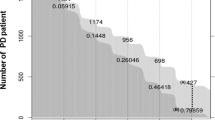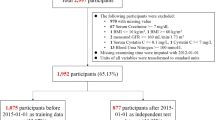Abstract
This paper addresses the important intelligent predicting problem of peritoneal absorption rate in the peritoneal dialysis treatment process of renal failure. As the index of dialysis adequacy, KT/V and Ccr are widely used and accepted. However, growing evidence suggests that the fluid balance may play a critical role in dialysis adequacy and patient outcome. Peritoneal fluid absorption decreases the peritoneal fluid removal. Understanding the peritoneal fluid absorption rate will help clinicians to optimize the dialysis dwell time. The neural network approach is applied to the prediction of peritoneal absorption rate. Compared with multivariable regression method, the experimental results showed that neural network method has an advantage over multivariable regression. The application of this predicting method based-on neural network in clinic is instructive.
Similar content being viewed by others
References
T. Wang, R.G. Ye, Peritoneal dialysis should be a prior treatment of Chinese ESRD patients, Chinese J. of Integrated Traditional and Western Nephrology, Vol. 3, No. 1, pp. 1 - 4, 2002.
N. H. Lameire, The impact of residual renal function on the adequacy of peritoneal dialysis, Contrib Nephrol, Vol. 124, pp. 76–93, discussion 93 - 102,1998.
T. Wang, B. Lindholm, CANUSA, DOQI, ADEMEX: what's next? Peril Dial. Int., Vol. 22, No.5, pp. 555–562, 2002.
R. N. Foley, P.S. Parfrey, M. J. Sarnak, Epidemiology of cardiovascular disease in chronic renal disease, J. Am. Soc. Nephrol, Vol.9, Supp., pp. S16–23, 1998.
O. Heimburger, J. Waniewski, A. Werynski, et al., A quantitative description of solute and fluid transport during peritoneal dialysis, Kidney Int., Vol. 41, No.5, pp. 1320–1332, 1992.
J. Waniewski, O. Heimburger, M. S. Park, et al., Methods for estimation of peritoneal dialysate volume and reabsorption rate using macromolecular markers, Pent. Dial. Int.,Vol. 14, No.l, pp. 8–16,1994.
T. Wang, O. Heimburger, J. Waniewski, et al., Time dependence of solute removal during a single exchange, Adv. Perit. Dial., Vol. 13, pp. 23–28, 1997.
J. B. Wang, C. R. Kang, The application of MATLAB neural network toolbox, J of Quanzhou Normal College (Natural Science), Vol. 19, pp. 80–83, 2001.
T. Wang, J. Waniewski, O. Heimburger, et al., A quantitative analysis of sodium transport and removal during peritoneal dialysis, Kidney Int., Vol. 52, No.6, pp.1609–1616, 1997.
L.N. Xu, Neural network control, Harbin Institute of Technology Publisher, Harbin, 1995.
Author information
Authors and Affiliations
Additional information
This work was supported in part by the guangdong Province Scientific and Technological key Research Program (No.2002C3021l) and the South China University of Technology.
Rights and permissions
About this article
Cite this article
Zhang, M., Hu, Y. & Wang, T. Intelligent predicting approach of peritoneal fluid absorption rate based-on neural network. J. Control Theory Appl. 1, 82–85 (2003). https://doi.org/10.1007/s11768-003-0013-3
Issue Date:
DOI: https://doi.org/10.1007/s11768-003-0013-3




